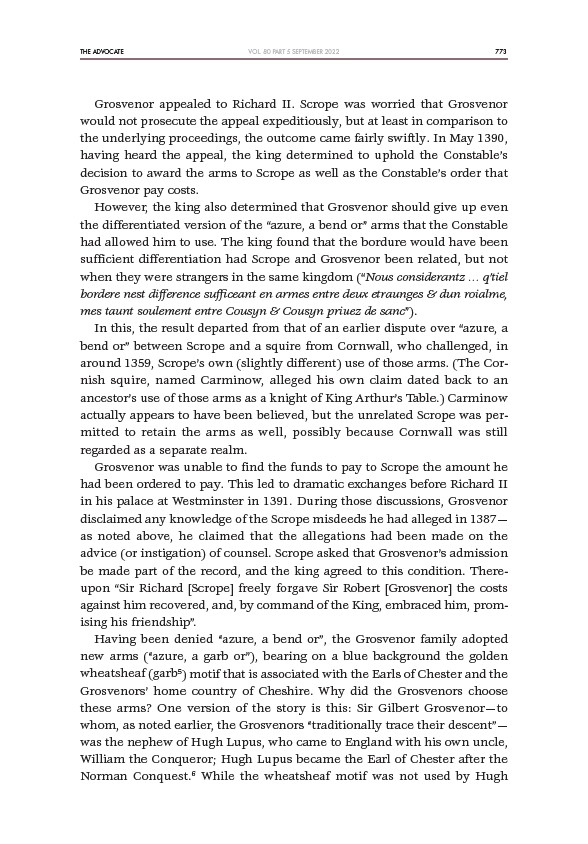
THE ADVOCATE 773
VOL. 80 PART 5 SEPTEMBER 2022
Grosvenor appealed to Richard II. Scrope was worried that Grosvenor
would not prosecute the appeal expeditiously, but at least in comparison to
the underlying proceedings, the outcome came fairly swiftly. In May 1390,
having heard the appeal, the king determined to uphold the Constable’s
decision to award the arms to Scrope as well as the Constable’s order that
Grosvenor pay costs.
However, the king also determined that Grosvenor should give up even
the differentiated version of the “azure, a bend or” arms that the Constable
had allowed him to use. The king found that the bordure would have been
sufficient differentiation had Scrope and Grosvenor been related, but not
when they were strangers in the same kingdom (“Nous considerantz … q’tiel
bordere nest difference sufficeant en armes entre deux etraunges & dun roialme,
mes taunt soulement entre Cousyn & Cousyn priuez de sanc”).
In this, the result departed from that of an earlier dispute over “azure, a
bend or” between Scrope and a squire from Cornwall, who challenged, in
around 1359, Scrope’s own (slightly different) use of those arms. (The Cornish
squire, named Carminow, alleged his own claim dated back to an
ancestor’s use of those arms as a knight of King Arthur’s Table.) Carminow
actually appears to have been believed, but the unrelated Scrope was permitted
to retain the arms as well, possibly because Cornwall was still
regarded as a separate realm.
Grosvenor was unable to find the funds to pay to Scrope the amount he
had been ordered to pay. This led to dramatic exchanges before Richard II
in his palace at Westminster in 1391. During those discussions, Grosvenor
disclaimed any knowledge of the Scrope misdeeds he had alleged in 1387—
as noted above, he claimed that the allegations had been made on the
advice (or instigation) of counsel. Scrope asked that Grosvenor’s admission
be made part of the record, and the king agreed to this condition. Thereupon
“Sir Richard Scrope freely forgave Sir Robert Grosvenor the costs
against him recovered, and, by command of the King, embraced him, promising
his friendship”.
Having been denied “azure, a bend or”, the Grosvenor family adopted
new arms (“azure, a garb or”), bearing on a blue background the golden
wheatsheaf (garb5) motif that is associated with the Earls of Chester and the
Grosvenors’ home country of Cheshire. Why did the Grosvenors choose
these arms? One version of the story is this: Sir Gilbert Grosvenor—to
whom, as noted earlier, the Grosvenors “traditionally trace their descent”—
was the nephew of Hugh Lupus, who came to England with his own uncle,
William the Conqueror; Hugh Lupus became the Earl of Chester after the
Norman Conquest.6 While the wheatsheaf motif was not used by Hugh